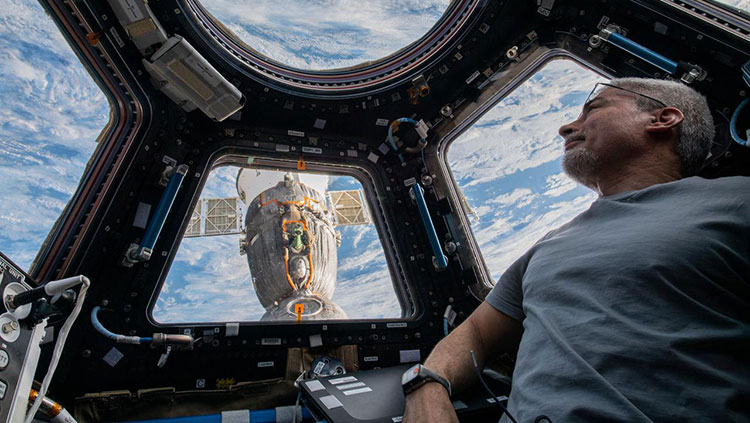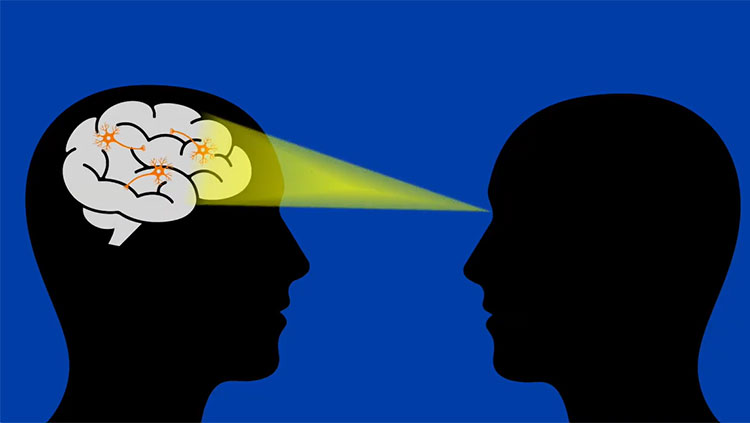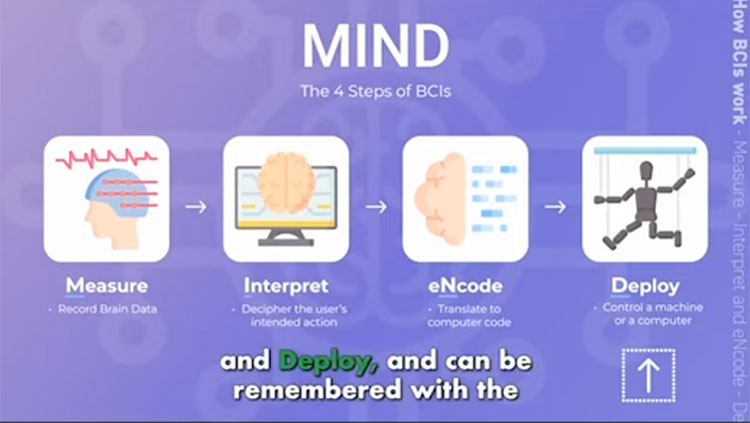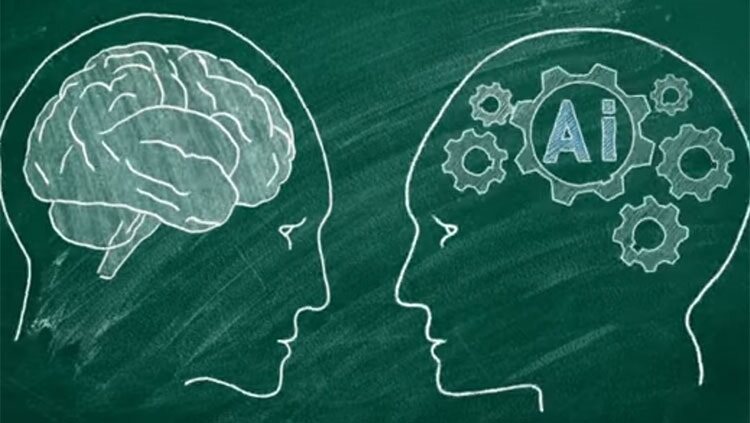Six Months in Space Changes Your Brain for Years
- Published17 Jan 2024
- Author Christine Won
- Source BrainFacts/SfN

Traveling to space goes beyond defying Earth's gravity: It confronts millennia of human evolution. In post-flight pictures, astronauts or cosmonauts have noticeable changes like puffier cheeks, broader shoulders, and scrawnier legs. This phenomenon is so common among astronauts they coined it ‘puffy head bird legs’, also known as “the Charlie Brown effect.” Without Earth’s gravitational forces, fluids in the body tend to shift upward, and the increased fluid in the cranial compartment shifts the brain higher in the skull.
Recent studies show the experience of microgravity — the condition where objects and people appear weightless and are able to float — can enlarge key structures in the brain that require healthy blood flow to support waste removal. Because the quality of blood flow in these areas is also related to dementias like Alzheimer’s disease, the findings may provide insight into why exercise is good for the brain.
Expanding Space
“Our body has evolved to work with gravity,” says Rachael Seidler of the University of Florida. For example, there is the vestibular system, which uses fluid changes to determine balance, motion, and equilibrium, or the circulatory system, which has evolved with one-way valves that ensure fluids pump throughout the body against gravitational forces. “You take us out of this mechanical environment in which we evolved and not everything works the same.”
The absence of gravity reduces white matter in the brain, alters sensory perception, and creates vestibular issues (which can cause space motion sickness), and spaceflight-associated neuro-ocular syndrome. “However, the exact changes in brain structure and function and their meaning and mechanisms, as well as the role of mission duration, sex, and phenotypic vulnerabilities are unknown,” Alexander Stahn of the University of Pennsylvania and colleagues wrote in a July review in NPJ Microgravity.
Seidler and colleagues evaluated the influence of various demographic variables such as astronaut age at launch, flight duration, time between missions, and those with previous space experience. They found spending six months in space semi-permanently changed key structures in astronauts’ brains that took three years to undo, according to the June 2023 study in Scientific Reports.
Previous research has shown ventricles — hollow cavities in the center of the brain filled with cerebrospinal fluid (CSF) — expand by up to 25% in microgravity. In the June study, periodic brain scans before and after spaceflight showed those who spent at least six months on the International Space Station (ISS) had enlarged ventricles, which only recovered an average of 55%-64% toward pre-flight size by the six- to seven-month postflight mark.
“Our body has evolved to work with gravity. You take us out of this mechanical environment in which we evolved and not everything works the same.”
—Rachael Seidler, University of Florida
This expansion in volume is significant. The clear CSF occupying the ventricular system and the perivascular spaces — the fluid-filled chambers surrounding blood vessels of the central nervous system — is responsible for protecting and nourishing the brain. In addition, CSF is an essential component of the glymphatic system, which removes waste such as the amyloid beta and tau proteins often associated with Alzheimer’s.
In the June study, 30 participants were divided into three groups by spaceflight duration: two weeks, six months, and one year. Comparing MRIs from six months pre-flight with several follow-up post-flight imaging scans showed those in space for six months saw the greatest ventricular expansion — up to more than 0.75 mL change in volume.
Yet there was also good news: This enlargement appeared to level off in those who had been in space for a year, meaning astronauts on longer-term missions to Mars, for example, would likely not see continued inflation.
Coming Back Down to Earth
Among the 18 participants with previous spaceflight experience, researchers saw ventricles expand in those whose previous mission was at least three years ago but not in those who had flown to space within the past one to three years. Seidler says this suggests their ventricles did not regain full elasticity for three years. While the length of time to recovery is surprising, Seidler says there may be adaptive advantages behind the brain’s slow acclimation.
“This is an important paper because most astronauts don’t routinely undergo follow-up MRIs multiple time points after spaceflight,” says Donna Roberts, deputy chief scientist at ISS National Laboratory, who was not involved in the study. She has long advocated for NASA to perform routine follow-up brain MRI scans. “It’s important to ensure that brain anatomy, such as the cerebral ventricles and perivascular spaces, re-adapts to the 1 gravity environment back on Earth — and not just in a few astronauts who are part of a study, but in all astronauts.”
The next question, researchers say, is what impact this will have on human health and performance. Age-related ventricular expansion due to natural brain atrophy is associated with cognitive decline, but more research is needed into the gravity-related condition. While astronauts did not report significant behavioral or cognitive issues in this study, researchers note they are also typically in better health than the average person and thus likely more able to compensate for any deficits.
Space brain studies also have key implications for people on Earth. Research indicates the importance of CSF and cerebral perfusion (blood flow to the brain) in the glymphatic system and for brain function. In a simulated space environment, researchers found that cerebral perfusion decreased while perivascular spaces expanded. This led to less efficient CSF circulation and could have implications for waste removal. “So we think that there's a link between blood flow to the brain and how efficiently your brain is able to remove waste products like amyloid beta, which can accumulate in diseases such as Alzheimer's,” Roberts says. “This supports why we should exercise, which increases blood flow to the brain, helping keep us healthier, perhaps by more efficiently driving waste removal through the glymphatic system.”
CONTENT PROVIDED BY
BrainFacts/SfN
References
McGregor, H. R., Hupfeld, K. E., Pasternak, O., Beltran, N. E., De Dios, Y. E., Bloomberg, J. J., Wood, S. J., Mulavara, A. P., Riascos, R. F., Reuter-Lorenz, P. A., & Seidler, R. D. (2023). Impacts of spaceflight experience on human brain structure. Scientific reports, 13(1), 7878. https://doi.org/10.1038/s41598-023-33331-8
Stahn, A. C., Bucher, D., Zu Eulenburg, P., Denise, P., Smith, N., Pagnini, F., & White, O. (2023). Paving the way to better understand the effects of prolonged spaceflight on operational performance and its neural bases. NPJ microgravity, 9(1), 59. https://doi.org/10.1038/s41526-023-00295-y
Tidwell, J. B., Taylor, J. A., Collins, H. R., Chamberlin, J. H., Barisano, G., Sepehrband, F., Turner, M. D., Gauthier, G., Mulder, E. R., Gerlach, D. A., & Roberts, D. R. (2023). Longitudinal Changes in Cerebral Perfusion, Perivascular Space Volume, and Ventricular Volume in a Healthy Cohort Undergoing a Spaceflight Analog. AJNR. American journal of neuroradiology, 44(9), 1026–1031. https://doi.org/10.3174/ajnr.A7949
What to Read Next
Also In Tech & the Brain
Trending
Popular articles on BrainFacts.org



















